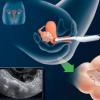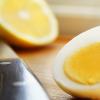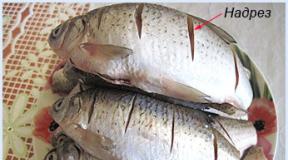Proper loading of the dishwasher. How to properly load a dishwasher with dishes Installing dishes in the dishwasher
Full instructions: how to properly load dishes into the dishwasher
It is important for the lucky owners of a new kitchen helper to know how to load dishes into the dishwasher A dishwasher is still a luxury for many, but those who have purchased a dishwasher can appreciate how such an everyday household issue has been simplified. True, immediately after the purchase several dubious moments arise - not everyone thinks to carefully study the instructions, or they simply do not fully understand it. For example, how to load dishes? Is it important how it is placed in the car?
Preparation: How to load dishes into the dishwasher
For some reason, some owners ignore this point - namely, preparing the dishes for washing. You need to remove any leftover food from the plates yourself (large ones, of course). The better you do this, the better the dishes will be washed. It will not be possible to wash the same plates on which salad or meat and pasta are left.
Before loading dishes into the machine, they must be cleared of food residues, for example, with a napkin.
You can clean dishes with kitchen napkins, a sponge or a silicone spatula - there are many ways. It is very important that there are no legumes, fruit pits, corn, hard grains, etc. left on the plates.
Another common question is whether it is correct to rinse dishes before putting them in the machine? If you are going to wash the plates immediately after eating, this is not necessary. But if you have accumulated a mountain of unwashed dishes, and they have been sitting like that for several hours, then a little rinsing will allow the dishes to be washed better. But many modern machines are equipped with a pre-rinse function, which makes the job easier.
Glasses and cups when loading the dishwasher
So, how to properly arrange dishes in your smart unit? Let's start with drinkware: that is, glasses, cups, mugs, glasses. Usually the top tray in the machine is intended for these devices. Place cups and glasses upside down so that the water washes their inner surface and then flows down. But you can’t fold it horizontally: almost no water will get inside.
Glasses and cups should be placed on the top tray with the bottom up
Also consider the following nuances:
- Glasses and wine glasses are secured with a fragile stem on top, in a special holder;
- The glasses should not touch each other - otherwise the glass may break during the washing process, keep this in mind before laying it out;
- Also, the plastic holder can be used for small coffee cups.
You need to place objects, securing them well so that nothing turns over under the running water. When you slide this top tray in, make sure nothing is loose. That is, you need to lay it carefully, firmly, the placement should be such that the glasses do not hit each other.
Different plates: how to put dishes in the dishwasher
Plates, depending on their type, can be placed either on the upper or lower tray. On the top tray you can place: bowls, saucers, gravy boats, bowls, scythes, salt shakers, dessert plates. If the water heats up to a relatively low temperature, plastic dishes can also be placed on the same top tray. You just need to place it away from the heating element, otherwise it will melt.
After placing all the items inside the appliance, it is important to ensure that the glassware is firmly in place.
The lower tray contains:
- Soup bowls;
- Medium diameter plates;
- Large diameter plates;
- Plates for serving assorted meats (meat, vegetables).
Large plates are placed along the edges, and plates with a smaller diameter are placed in the center. This will ensure better water access to the entire upper tray. It is imperative to install the plates facing the center of the unit so that they do not touch each other. And the larger the gap between the plates, the better they will be washed. If the dishwasher allows, then place plates less often.
Cutlery: how to arrange dishes in the dishwasher
Cutlery includes spoons, large and small, forks, as well as special serving knives. For these devices, every car, be it Bosch or a more modest device, has a special basket. On some models this is the topmost tray.
Cutlery should be placed in a special container with handles facing down.
Place spoons and forks freely, alternating with each other. And if you put them in tightly, they won’t wash properly. Knives are always placed with the blades down.
Another common question: how do you wash pots in the dishwasher? All large dishes, including pots and pans, are located in the lower container. Wash metal and glassware separately to ensure their safety. When washing metal utensils, a more intensive mode is used.
Please also consider these points:
- Baking trays and frying pans are always placed sideways;
- Pots are placed upside down or at an angle;
- Some models with Teflon coating cannot be washed in the dishwasher - if there is a manufacturer’s prohibition, do not ignore it;
- If you can remove the pan from the wall with a handle, be sure to remove it before putting it in the machine.
But is it possible to wash spatulas, skimmers, ladles, and cutting boards in the dishwasher? There is no prohibition as such if these utensils are not wooden and, preferably, not plastic. Wooden items should never be placed in the dishwasher.
Usually the model itself indicates how many sets of dishes it can wash in one cycle. Small machines can handle six sets of dishes at a time, narrow ones can handle eleven, and large units can wash up to seventeen sets of dishes per cycle. At the same time, you should never load the machine to capacity, this will affect the quality of washing.
Many owners of expensive cutlery from global manufacturers load cutlery at random, which can result in breakdown
When placed in the car, objects should not touch each other. Do not mix both plates and pans in the same cycle. Do not swap dishes - cups should be in their tray, plates should be in theirs. Don't forget to put in the dishwasher tablet on time. If you wash so that all the dishes are washed only in the evening, collected during the day, then immediately after eating, put them in a container - there the remains of food will not dry out on the plate, and it will be easier to wash it.
How to properly load a dishwasher (video)
Do not violate the rules for operating the dishwasher, try to clean the dishes from large food residues, and arrange the dishes correctly. And then the machine itself will serve faithfully, and the dishes will not break.
Life can be pleasant too!
Nowadays such a miracle appliance as a dishwasher is gaining more and more popularity. But new users often don’t know how to properly load dishes into the dishwasher. After the end of the program cycle, you may see smudges or washing powder on the plates. Therefore, knowing the loading rules will make life much easier for the housewife.
Preparatory work
Before loading the dishwasher, you must clean kitchen utensils from leftover food. If you don’t do this, the household appliance filter will quickly become clogged, and this will reduce the quality of the wash. Clear food from plates, pour out leftover tea, remove oil from frying pan, etc.
The problem of choosing detergents for the dishwasher worries many. There are several options currently offered on the market:
- washing tablets;
- powder;
- rinse aid;
- 3 in 1 tablets.
Each housewife decides for herself what to choose. Most popular options Powder and rinse aid are considered.
First stage
 Before figuring out how to properly place dishes in the dishwasher, you need to determine what type of dishwasher you have; the placement will depend on this. Mostly there are one- and two-tier options.
Before figuring out how to properly place dishes in the dishwasher, you need to determine what type of dishwasher you have; the placement will depend on this. Mostly there are one- and two-tier options.
If the machine is single-tiered, then tableware should begin with large items, such as a frying pan. They need to be placed in the center. The plates must be placed between the teeth. The mugs are on the side. The arrangement may vary depending on the model, but the general principle is as follows.
If the machine is two-tier, then plates and mugs are loaded into the upper compartment. If deep cups do not fit into the upper compartment, you can place them in the lower basket in special teeth. Pots, pans and similar large utensils are also placed in the lower tier.
Cutlery is placed in a special container. Knives - blade up, spoons - handle down. If the container is not included, you can place large appliances in the upper basket. Bosch machines now have horizontal loading facilities.
Make sure there is enough space between dishes for washing. Objects should not be close to each other. Nothing should prevent the spray rocker arms from spinning. Place mugs and glasses with their necks down so that water can wash them from the inside and drain freely. Install deep plates at an angle.
Do not place very small kitchen items in the dishwasher; they may fall out of the compartment.
Loading dishes into a Bosch dishwasher follows the same procedure. First you need to clean the cutlery from food debris, then arrange it in accordance with the picture attached to the instructions for the machine.
Final loading stage
 After all the kitchen utensils are arranged, you need to pour detergents into the compartment specially designed for this. Make sure that this compartment is dry, otherwise the machine will not wash out all the powder from there, and particles of chemical compounds will remain on the dishes and then mix with food. This can lead to health problems.
After all the kitchen utensils are arranged, you need to pour detergents into the compartment specially designed for this. Make sure that this compartment is dry, otherwise the machine will not wash out all the powder from there, and particles of chemical compounds will remain on the dishes and then mix with food. This can lead to health problems.
So, you need to add powder. Its portion depends on the completeness of the load. Usually 30-60 g is enough. There are marks in the compartment for the amount of detergent to be poured. Rinse aid is poured into another compartment; its volume also depends on the load level of the machine.
If washing tablets are used, then place one piece in the powder compartment.
Mode selection
Now you need to decide which washing program to set. For example, on a Bosch machine there are 4 modes:
- 70 degrees for washing pots or heavily soiled dishes;
- 50 degrees for washing medium soiled items;
- 45 degrees for washing glass items or lightly soiled dishes;
- rinsing mode.
It is worth mentioning the last program separately. It must be used in cases where food has already dried on the kitchen utensils. The machine will rinse the dishes, and the quality of subsequent washing will improve.
Tableware that should not be put in the dishwasher:
- wooden plates and cutlery;
- crystal and painted glass glasses;
- kitchen items made of plastic, not intended for exposure to high temperatures;
- utensils made of copper and tin.
Removing kitchen utensils
 You should start unloading the dishwasher from the bottom section so that water from the top dishes does not get onto the first tier. Even though the equipment is equipped with a drying program, drops of water still remain.
You should start unloading the dishwasher from the bottom section so that water from the top dishes does not get onto the first tier. Even though the equipment is equipped with a drying program, drops of water still remain.
So, understanding how to properly load your dishwasher is not a very difficult task. Over time, experience comes in correctly arranging plates and bowls, arranging glasses and mugs, placing pans and pots. Subsequently it will take very little time. Enjoy!
Attention, TODAY only!
How to load the dishwasher? This question is often asked by housewives who recently purchased a dishwasher. Loading a dishwasher is actually not difficult, but it must be done properly. This will help the dishes rinse better, which means they will be sparkling clean. Let's take a closer look at how to load a dishwasher.
After lunch is over, you need to clean the dishes from large pieces of leftover food, seeds, seeds or corn kernels. It’s easier to do this directly into the trash can using a spoon, napkin or rubber spatula.

If, after washing dishes in the dishwasher, you find that small grains, such as rice, remain on some plates, then you need to make a note to yourself not to let the dishes dry out after eating or to set a more powerful washing mode.

3. Washing dishes before loading is required, but not always.
Some dishwashers or dishwasher detergents work better after the dishes are rinsed before loading. This is also true if you accumulate dishes in the machine as they become dirty, since food residues dry out over time and are more difficult to separate from the dishes.

If you realize that you need to wash off any residue from the dishes before loading the machine, it’s easier to do this with a dishwashing brush. This way you will save your hands and your manicure will not suffer.

5. Observe what is washed and how well it is washed in different modes.
The first few times you wash dishes in the dishwasher, it's worth watching how protein foods, such as eggs or cheese, baked foods and starches, are rinsed. Such products stick quite strongly to dishes and require special attention. Try to immediately decide which mode is best for washing dishes after one or another difficult-to-rinse food.

If you think your dishwasher is not doing its job well, pay attention to the detergents you use. Don’t be lazy and purchase several options of products from different manufacturers at once and compare them in operation. In comparison, you can choose the best option for yourself.

When loading dishes, insert the plates into the slots on the bottom of the dishwasher, facing the center and tilting them slightly forward. Try not to allow one dish to touch another to ensure good flow of water from the spray nozzles.

Place cups, glasses, small bowls on the top of the dishwasher so that they are upside down, if not completely, then at least tilted. This is necessary so that the washing solution, as well as the rinsing water pressure, can reach all the inner sides of the dishes.

9. Be careful - plastic.
If you need to wash plastic dishes, it is better to place them at the top of the dishwasher. This is due to the fact that the heating element is usually located at the bottom, which means that plastic dishes located on the bottom shelf can become deformed.
10. Pots and pans.
Pots and pans should be placed on the bottom shelf with the open side down or at an angle.
11. Attention! Cutlery.

- *For cutlery, the dishwasher comes with a special basket in which you need to place the cutlery with the handle down.

- *Arrange cutlery freely, separating each one from each other, so that water can reach each individually.

- *Long cutlery can block the spray arms, so it is best to place them in the top rack of the dishwasher.

- *Teaspoons can be placed in special compartments if available in your dishwasher.

12. Small importances.
Make sure that there are no places on the dishes where water can accumulate and remain there until the end of the wash. Also be careful when washing good knives. The fact is that the edge of the knife during washing can come into contact and rub against other cutlery, which undoubtedly has an adverse effect on sharpening. It is better to wash such knives by hand, especially if their handles are made of wood.

13. Spoon / Fork.
Try to mix types of dishes and cutlery to avoid contact of the same type and sticking together. This effect also interferes with proper washing of dishes.

14. Cutting boards.
Place cutting boards on the outside of the bottom compartment of the dishwasher if they do not fit into the plate slots. But keep in mind that sometimes it is better to wash the board by hand, since the temperature of the dishwasher often warps cutting boards.

15. Proper use of detergents (dishwasher tablets, dishwasher powder, soluble powder and rinse aid).
Filling the dishwasher with detergents must be done according to the rules. The dishwasher is always equipped with special compartments for detergents. So, for example, if you use dishwasher tablets, then you just need to put one in the special one. container and close the lid. The same container is provided for filling dishwasher stains. Pour in the amount of powder indicated on the pack and close the lid. It’s easier if the powder is already dosed and packaged in a soluble shell. You can place it in a container like a regular dishwasher tablet and close the lid. If you use liquid dishwasher rinses, then there is another reservoir for them, into which you need to fill up to the indicated line or dose recommended by the manufacturer of the rinse aid for the dishwasher.

16. Filling the dishwasher with all the detergents at once is not always correct.
Filling two sections with detergent and rinse aid at once is not always necessary, although dishwasher and detergent manufacturers recommend the opposite. Often it is enough to use only detergent. This is convenient for saving rinse aid. Rinse aids are best used in case of heavily soiled dishes or when washing glass and crystal.

17. "Jet-Dry" function.
Some dishwashers have a "Jet-Dry" rinse aid feature. To use it, you need to fill the rinse aid up to the indicated mark on the rinse aid reservoir. This feature helps reduce water consumption, especially if you have hard water. With this type of dishwasher, there is no need to add rinse aid every time you start the machine. It is enough to add it once every couple of weeks or according to the instructions for use.

- *Remember that some detergents already include rinse aid. Read the product label carefully.
- *If your water is soft enough or you soften it with the help of some preparations, then you may not need rinses at all. Observe the quality of washing in this direction too.
Before starting the dishwasher, make sure that fragile items are not touching each other, as this is dangerous due to vibration during wash cycles.

19. Mandatory condition.
Before closing the dishwasher door and starting the washing process, be sure to check the rotation of the sprayer. It is important that nothing prevents the sprayer from turning freely and performing its function.

20. A clogged pipe is dangerous. How to avoid it?
The dishwasher drain often communicates with pipes leading from the sink. It is very important that the pipes always have a good flow of water, since any blockage can cause a blockage in the pipes and water from the dishwasher will not be able to go down the drain. We advise you to use what is called a sink waste disposer. This unit is designed for grinding solid food waste. It is installed in the kitchen sink drainage system and allows owners to forget about blockages and any other problems with drainage.

If you don't have a sink disposer installed, always use a sink filter, cleaning it from time to time. Also make sure the filter is clean.
21. The amazing is nearby.
If you use a dishwasher in your country house or in a private house with a garden or vegetable garden, then you can safely use the used water after washing dishes to water your plants. This is not only not harmful, but also useful. Don't forget to cool the water before watering.

22. Everything is ready.
Well, the last step - all you have to do is select exactly the function that is suitable for this particular dirty dishwasher, then close the door and start the dishwasher.

- *Make sure that the water temperature is always hot enough. Lack of temperature in the water will save energy, but the dishes may not be washed properly.
- *Make a habit of putting dishes straight into the dishwasher rather than leaving them in the sink.
- *Some dishwashers do not have a sprayer under the top rack. In such machines, you need to ensure that the dishes in the upper basket are washed and nothing interferes with this. If this does not happen, then perhaps a large object located on the bottom of the dishwasher is simply blocking the passage of water. For better cleaning in such a dishwasher, it is better to install only plates between which water will flow well, and wash the pots either by hand or the next time.
- *For better cleaning, place cutlery with handles facing down.
- *Cleaning the dishwasher with a full load actually saves water compared to washing dishes by hand, especially if you don't pre-rinse.
- *Place similar dishes of equal sizes nearby. This download is more convenient.
- *To increase energy saving, run short washing modes, which can also easily cope with washing dishes that are not heavily soiled. It is better to use powerful washing cycles for heavily soiled dishes and if the dishes have already been standing for some time and have dried out.
- *If you can check the drying function, it is better to abandon it altogether. After washing the dishes, simply open the machine door slightly and allow the dishes to dry naturally. This method also saves energy.
- *Load the dishwasher with dirty dishes immediately after eating, even if you plan to run it later. There's no point in loading up the sink when you can put everything in the dishwasher. It's much more convenient.
- *Store all dishwashing products in a dry place, even if you have not yet unpacked them.
- *If you can set the water temperature yourself, then the optimal temperature is 50 degrees C. If the water is colder, this may affect the quality of washing dishes, and if it is hot, you can get burned.
WARNINGS:
- *Use the dishwasher only for washing dishes. Also, do not put regular dishwashing liquids into the dishwasher.
- *Wooden products must be washed by hand, including if only the handle is made of wood.
- *Install fragile wine glasses with extreme caution, as they tend to simply break when vibrated.
- *Do not load very large items into the machine as this may cause difficulty opening the dishwasher.
- *If you find residues of detergent in the container, then you must add exactly the same detergent from the same manufacturer.
- *Avoid putting silver, aluminum and other reactive metals in the dishwasher as they may stain and damage the finish.
- *For your safety, make sure the blades are positioned point down.
If there is a dishwasher in the house, disputes about who washes the dishes should be over. But with a new assistant comes new responsibilities. Its owners will not only have to take care of its cleanliness and serviceability, but also correctly arrange plates, cups and cutlery in it. Let's figure out how to load dishes into a dishwasher (DMM).
Preparing for washing
The first load takes 20 minutes for users who have no experience with a dishwasher. Having acquired the dexterity, dishwasher owners cope with the task of loading a standard batch in half the time; it takes 10 minutes.
Before placing plates in baskets, they are cleaned of food residues, otherwise they will then have to be removed from filters, hoses and pipes. It is better to remove food in advance rather than disassemble and clean problematic units. This can be done conveniently with napkins, sponges, or a rubber spatula. No solid food should be allowed into the hopper.
Pre-rinse
Do I need to rinse dishes before putting them in the dishwasher? Thanks to rinsing, any utensils are washed better. But then the question arises: why spend money on PMM if you have to remove half-eaten food, lay out the plates correctly, and even pre-rinse it? If you load the plates immediately after eating, you won’t have to do anything; they will wash perfectly. But if the food is dry, then the plates and bowls should be rinsed before loading into the hopper.

How to place mugs and glasses?
Let's start with the arrangement of cups, mugs and glasses. They are placed in the top container, upside down, the water will wash them from the inside. If you place them on their side, horizontally, they will not wash off and water from the spray nozzles will not get inside them.

There are special holders for glasses. Wine glasses are placed with the stem up. It’s a bit cramped in the bunker, and users are wondering if it’s possible for the glasses to touch? It is forbidden. When washing, glass can break due to micro-collisions of neighboring wine glasses. In addition to glasses, the plastic holder will comfortably accommodate coffee cups.
The “seat” for plates is determined according to size and shape. It is better to put small items in the upper basket; it is suitable for bowls, gravy boats, salt shakers, bowls, dessert plates, bowls and saucers.

If the washing is carried out with a slight heating of the water, it is allowed to place plastic products at the top; they are placed at a distance from the heater to avoid deformation of the material.
The lower basket is filled with soup bowls. Large ones are placed around the edges. The smaller ones are in the center. This is done to ensure access of water to the upper tray. The plates are placed with their front sides facing the center point of the chamber, so that adjacent bowls do not touch. A large gap between the “neighbors” ensures high-quality washing; this is the main principle of correct loading.
Arrangement of cutlery
Knives, forks and spoons of all types and sizes, collectively referred to as cutlery, are placed in a separate basket. Arrange them freely, trying not to place identical devices next to each other. If packed tightly, spoons and forks will not be washed. The position of the knives is strictly with the blade down.

New PMM models from the Bosch and Siemens brands are equipped with a special tray for spoons and forks. It is located upstairs. The devices are placed in a horizontal position; this is economical, safe and ensures high-quality washing.
How to place large dishes?
Baking trays, frying pans, saucepans, etc. placed in the lower container. It is recommended to arrange a separate wash for it without glass, porcelain and crystal items. It is better to wash them intensively, in hot water. Pans and baking sheets are placed on their sides, pots are turned upside down, or placed diagonally. Thanks to a reasonable arrangement, water jets will reach each product, and there will be no obstacles to access to the top.

The removable handles of the pans are removed. They must not touch the walls of the chamber. When placing large dishes in the lower tray, the main thing is not to turn them upside down, otherwise water will not get to the top. If you do decide to place the pots this way, then do not place anything on top and use the “half load” mode. This way you will reduce your water and electricity consumption. Place baking sheets on the sides of the lower basket.
What about kitchen utensils?
What about ladles, skimmers, cutting boards? They can be washed in a machine if they are not made of wood or plastic. Plastic items can be placed on top, boards on the sides of one of the trays. It is better to wash cutting boards by hand. Ladles and skimmers are placed horizontally.

How much does it fit?
How many pots, plates and spoons can you wash at once? Read the instructions to see the capacity. Unit of measurement sets. In small-sized PMMs, 6 sets are washed per cycle, in narrow ones no more than 11, in full-size ones no more than 17.

A set is a set of dishes needed by one person. The manufacturer knows what is included in the kit. Approximate contents: a couple of plates, cutlery, a cup. In fact, the machine fits about 12-14 sets. If you need to wash an additional couple of pots and pans, then less.
- Do not cram a lot of dishes at once; leave space between adjacent items.
- Before loading the product into the chamber, look for signs on it that allow or prohibit washing in a dishwasher.
- Place large items, such as frying pans, away from fragile items.
- Do not load wood products.
- Immediately send dirty plates to the chamber, then the food on them will not dry out and they will be easy to wash.
The dishwasher doesn’t care what you put in it - everything will be washed to perfect cleanliness, just add the appropriate detergent and arrange the dishes as expected.
It’s simple when you are the owner of an experienced dishwasher and you put plates on the machine, you don’t think about what to put where. The question of how to load dishes correctly and ensure that everything is washed will most likely arise for the happy owner of his first dishwasher.
Preliminary preparation
First of all, set aside items that cannot be washed in a machine, and remove waste from the rest:
- Remove pieces of food from surfaces with a spatula, sponge, or paper towel; you can rinse, but do not wash;
- drain the used frying oil and wipe off the grease from the pans with a napkin;
- Soak heavily dried residues in hot water for 5 minutes;
- Wipe off sticky egg and cheese traces with a sponge - they are difficult to clean even with strong detergents;
- The rims from broths and soups on the walls of pans disappear only on long programs with strong water heating and with powerful tablets - to wash on short cycles, go over them with a sponge.
How to arrange dishes
Basic Rules:
- We place large items in the lower basket, mugs, small and fragile items in the upper one;
- We install the larger diameter at the edges, the smaller one closer to the center;
- Place the containers with the holes down and at an angle;
- We place it firmly so that it does not tip over;
- tall objects should not interfere with the rotation of the rocker;
- place the utensils compactly, but not tightly - water needs to get freely into all corners.
We begin the arrangement with cutlery, then fragile dishes, large objects, and in the unoccupied space we lay out what remains.

Spoons, forks, knives
In advanced models of dishwashers there is a third level for cutlery - place them in it as indicated in the instructions.
Most dishwashers are equipped only with a special basket. If it has an upper grid, then spoons and forks are placed in separate cells with their handles down, and knives with their handles up. If the basket is open, then the cutlery is mixed so that they alternate and do not stack on top of each other.
The basket is not useful if you have a small number of spoons and forks - they will fit in the upper compartment on the shelf for coffee cups.
Caution - fragile
It is more convenient to wash short, thin wine glasses and wine glasses in a special holder. This accessory holds 4 or 8 wine glasses, depending on the model, but is not cheap and must be purchased separately.
You can do without a holder: in the upper tier, place the glasses sideways, resting their stems on the shelf for cups, and without touching each other. In a machine of standard depth, 4 glasses can fit, or 5 glasses back to back, which is undesirable if a standard washing program is used.
Thin glass is fragile - wash only on delicate cycles at low temperatures.

Another 2 glasses can be placed on the opposite side, fixing them on pins.
With tall wine glasses, you will need to lower the upper basket (if your dishwasher model has this) and raise the shelf for cups.
Mugs and glasses
The upper tier is intended for them. The main rule is to turn mugs and glasses upside down and place them at an angle, so the water drains better. You can place them in several rows and close together.
Baking dishes and baking trays
Large baking sheets are washed separately from other dishes, because... They won’t fit vertically, and lying down will block the splashing of water from below.
Narrow sheets are placed on the side or to the back wall of the machine to maintain free space for the plates. The sides of the baking dish are wide - place them in the back, standing on the edge.
If there are not enough dishes, the molds can be washed by folding special pins (these are available in the Bosch PMM).
Pans and pots
The removable handles must be detached.
Large utensils are cleaned better in the lower basket. Only low saucepans and ladles are suitable for loading the upper level, while the lower level has more space and objects are better washed on both sides.
It is convenient to place large pots by folding the pins in the lower tier or resting them sideways on a basket with cutlery. If there are not many frying pans, place them like molds - sideways.

Lay the pans while lying down in the same way, the main thing is to fold the pins, do not put the non-stick coating directly on them, it will get scratched.
A full-size dishwasher can wash up to 4 pans at once by staggering them. With this arrangement, nothing else will fit in the bunker - a maximum of 1 lid and some small items in the upper compartment.
Cutting boards
Only glass and plastic boards can be washed in the dishwasher. The optimal place for them is on the sides so that they do not block other dishes.
Meat fibers are difficult to wash off from plastic boards - wash them all off before putting them in the machine.
Plastic containers
The placement of containers is similar to that of mugs - at the top and at an angle. The plastic is lightweight, so the containers can tip over due to the pressure of water and will not be washed. Press them down with dishes, or secure them with special holders.

The containers fit perfectly in the space under the shelf for cups - they are fixed there, and the shelf protects them from tipping over.
Plates and bowls
In the unoccupied places of the lower section, we place the plates with the front side to the center: large ones at the edges, and the average diameter and saucers - closer to the middle.
Life hack - between the rows you can put a couple more small plates, boards, plastic lids.
We fill the empty areas of the upper tier with small plates, saucers, container lids, bowls and various bowls - we lay them at an angle or lean them on other objects.
Ladles, spatulas and other tools
Long kitchen utensils are placed in the upper tray between the utensils, or on the shelf for cups. It is important to place them so that during the washing process the handles do not fall through the basket bars and block the spray arm.
Check before starting
After distributing the dishes, make sure that there is enough space for the top spray arm to rotate - there should be at least 3-5 centimeters to the highest item.
Also, nothing should prevent the dispenser lid from opening and tablets or detergent powder falling out of it - do not place any high objects in the lower tier near the door.
What to do with half load
When there are few dishes, the layout follows the same rules, but more freely.
If your dishwasher has a “half cycle”, use it: reduce time, plus save on water and electricity.
- do not place very dirty items in the corners - they are washed better in the center;
- do not wash greasy frying pans with delicate and fragile ones - a coating will remain on the glass;
- if there are a lot of dirty large utensils (pans, pots, molds) - do not overload the machine, wash them separately.
The article describes how to load a standard depth dishwasher. But these tips also apply to desktop PMMs - you just need to adapt to the compact size of the devices.



















